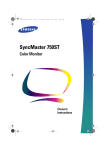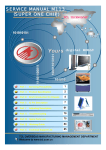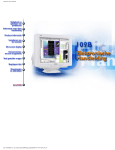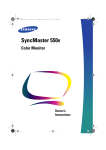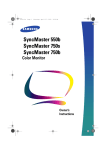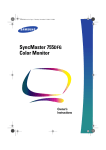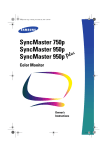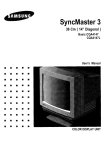Download Samsung SyncMaster 700S Specifications
Transcript
Samsung SyncMaster 700s Color Monitor Owner’s Instructions CAUTION RISK OF ELECTRIC SHOCK DO NOT OPEN CAUTION: TO REDUCE THE RISK OF ELECTRIC SHOCK, DO NOT REMOVE COVER (OR BACK). NO USER-SERVICEABLE PARTS INSIDE. REFER SERVICING TO QUALIFIED SERVICE PERSONNEL. The lightning flash with arrowhead symbol, within an equilateral triangle, is intended to alert the user to the presence of uninsulated “dangerous voltage” within the product’s enclosure that may be of sufficient magnitude to constitute a risk of electric shock. The exclamation point within an equilateral triangle is intended to alert the user to the presence of important operating and servicing instructions in the literature accompanying the appliance. Unpacking your Monitor Please make sure the following items are included with your computer monitor: Power Cable This Manual Monitor and Stand Warranty Card (Not available in all areas) ii Signal Cable Table of Contents Preface: Safety Information Chapter One: Overview of Your Monitor Front Panel Rear Panel Chapter Two: Installation Connecting Your Monitor to a Computer Chapter Three: Adjusting Your Monitor Overview Direct Access Features Contrast Brightness Control Function Features Position(H/V) / User or Preset Model Size( H/V) Geometric Distortion (G/D) Color Temperature Recall Degauss PowerSaver Troubleshooting Appendix Specifications Pin Assignments Display Modes Timing Chart FCC Information IC Compliance Notice VCCI Information MPR II Compliance European Notice Index 2 3 3 4 5 5 6 6 6 6 6 7 7 8 8 9 9 9 10 11 12 12 13 13 14 16 16 16 16 17 1 Preface: Safety Information Please read and follow these instructions when connecting and using your computer monitor. 1 Before connecting the AC power cord to an outlet, make sure the voltage designation on your monitor corresponds to the local electrical supply. 2 Never insert anything metallic into the monitor openings. Doing so may create the danger of electric shock. 3 To avoid electric shock, never touch the inside of the monitor. Only a qualified technician should open the monitor’s case. 4 Never use your monitor if the power cord has been damaged. Do not allow anything to rest on the power cord, and keep the cord away from where people could trip over it. 5 Be sure to hold the plug, not the cord, when disconnecting the monitor from an electric socket. 6 Openings in the monitor cabinet are provided for ventilation. To prevent overheating, these openings should not be blocked or covered. Also, avoid using the monitor on a bed, sofa, rug, or other soft surface. Doing so may block the ventilation openings in the bottom of the cabinet. If you put the monitor in a bookcase or some other enclosed space, be sure to provide adequate ventilation. 2 7 Put your monitor in a location with low humidity and a minimum of dust. Avoid places like damp basements or dusty hallways. 8 Do not expose the monitor to rain or use it near water (in kitchens, next to swimming pools, etc.). If the monitor accidentally gets wet, unplug it and contact an authorized dealer immediately. You can clean the monitor with a damp cloth when necessary, but be sure to unplug the monitor first. 9 Place the monitor on a solid surface and treat it carefully. The screen is made of glass and can be damaged if dropped or sharply hit. Locate your monitor near an easily AC outlet. 10 accessible If your monitor does not operate – in particular, if there 11 normally are any unusual sounds or smells coming from it – unplug it immediately and contact an authorized dealer or service center. temperatures can cause 12 High problems. Don’t use your monitor in direct sunlight, and keep it away from heaters, stoves, fireplaces, and other sources of heat. the monitor when it is going to be left unused for an 13 Unplug extended period of time. Unplug your monitor from the AC before any service. 14 outlet Chapter One: Overview of Your Monitor English Front Panel Function control buttons 1 Use these buttons to control the shape of the display area, and to control the color qualities of the display image. 2 Brightness 3 Contrast 4 5 Use this rotary control to adjust the overall brightness of the display image. Use this rotary control to adjust the contrast level of the display image. Power indicator This light glows green during normal operation, and glows amber when you are making adjustments. Power button Use this button to turn the monitor on and off. 3 Chapter One: Overview of Your Monitor 3 Rear Panel 1 2 4 Power port Connect the power cable here. Signal port Connect your signal cable here. Chapter Two: Installation English Connecting Your Monitor to a Computer 1 2 3 4 5 Connect the signal cable (with the adapter if necessary) to the video port on the back of your computer. This port might be directly attached to your computer, or it might be part of a video board, video card, or graphics card. 6 Connect the power cord for your monitor to the power port on the back of the monitor. 7 Plug the power cords of your computer and your monitor into a nearby outlet. 8 Turn on your computer and monitor. If your monitor displays an image, installation is complete. Turn off your computer and unplug its power cord. Connect the signal cable to the signal port on the back of your monitor. If you are using a Macintosh computer, connect the other end of the signal cable to a Macintosh adapter. (The adapter is not included with your monitor. Contact your dealer for more information.) If you are using an IBM-compatible computer, skip to step 5. Follow the instructions included with your adapter to set the pins on your adapter, if necessary. 5 Chapter Three: Adjusting Your Monitor Overview Your Samsung SyncMaster computer monitor allows you to easily adjust the characteristics of the image being displayed. All of these adjustments are made using the control buttons on the front of the monitor. While you use these buttons to adjust the controls, an on-screen menu shows you their numeric values as they change. Direct-Access Features The features described on this page can be accessed quickly, at the touch of one button. Contrast This feature will adjust the monitor’s contrast. Rotate the rotary control to the right to increase the contrast between dark colors and light colors, or move it to the left to decrease the contrast. Brightness This feature will adjust the overall brightness of the display image. Rotate the rotary control to the right to increase the level of brightness, or to the left to decrease the brightness. 6 Chapter Three: Adjusting Your Monitor Control Function Features The features described in this section can all be accessed using your monitor’s control function buttons. While implementing control functions, the indicator’s color is orange. However, you cannot adjust the display image while a control function is disabled (the indicator’s color is green). Most features use only one button for access, however some features require that you push two buttons. Follow the instructions below to adjust the features. The monitor will automatically save your changes when the OSD remains inactive for approximately 8 seconds. Position (H/V) / User or Preset Mode First Function: Position (H/V) Follow these instructions to change the position of the monitor’s entire display. 1 2 Push this button once to adjust the horizontal and vertical position (centering) of the display. Use the 4 and b buttons to change the horizontal position of the entire display; use the V and A buttons to change the vertical position. Second Function: User or Preset Modes Push this button twice to access the user and preset modes information. The OSD shows the contents of the user modes and factory timing modes. Use the adjustment control buttons (V and A) to “page” through the list. 7 Chapter Three: Adjusting Your Monitor Size (H/V) Follow these instructions to change the size of the monitor’s entire display. 1 2 Push this button once to adjust the horizontal and vertical size of the entire display. Use the 4 and b buttons to change the horizontal size (width) of the entire display; use the V and A buttons to change the vertical size (height). Geometric Distortion (G/D) First function: Pincushion / Trapezoid Adjust the pincushion setting when the sides of the display are bowed in or bowed out.; adjust the trapezoid setting to equalize the length of the top and bottom edges. 1 2 Push this button once to access the pincushion and trapezoid functions. Use the 4 and b buttons to change the pincushion setting; use the V and A buttons to change the trapezoid setting. Second function: Parallelogram/ Tilt Adjust the parallelogram setting when the display is leaning left or right; adjust the tilt setting when the display area appears rotated to the left or right. 1 2 8 Push this button twice to access the parallelogram and tilt functions. Use the 4 and b buttons to change the parallelogram setting; use the V and A buttons to adjust the tilt setting. Chapter Three: Adjusting Your Monitor COLOR TEMP. Color Temperature Follow these steps to change the color temperature setting. Color Temperature is a measure of the “warmth” of the image colors. 1 2 Push this button once to access the color temperature function. Use the V and A buttons to select between the 9300K color and the 6500K color. Recall Use this button to return the settings to their original factory settings. Push and hold in the recall button for several seconds, or until the power indicator LED changes from orange to green. After pushing this button, a green LED indicates that the factory settings for the current video signal timing have been recalled. The OSD shows the progress of the recall function. Note : This operation resets all of the data in the user memory area for the current timing signal. Degauss The Degauss feature will remove any color impurity caused by magnetic fields. Do not use the Degauss feature more than once within a 30-minute period. Push the button once to activate the degaussing circuit. The monitor may buzz momentarily, the image colors may change and the image will jiggle for a few seconds. These effects are normal. The degaussing circuit automatically turns itself off after a few seconds. WARNING : Don’t push and hold the degauss button for longer than 5 seconds. If you do, this operation resets all of the data in the user memory area. If this occurs, you must remake your user adjustments. 9 Chapter Three: Adjusting Your Monitor PowerSaver This monitor has a built-in power management system called PowerSaver. This system saves energy by switching your monitor into a low-power mode when it has not been used for a certain amount of time. The available modes are “On,” “Standby,” “Suspend,” and “Off.” This system operates with a VESA DPMS compliant video card installed in your computer. You use a software utility installed on your computer to set up this feature. See the table below for details. State Power Saving function mode EPA/NUTEK Power-off Mode Standby mode Suspend mode Position A1 Position A2 Normal Operation Horizontal Sync Active Vertical Sync Active Video Active Inactive Active Blanked Active Inactive Blanked Inactive Inactive Blanked Power Indicator Green Amber Amber/Green Blinking Amber Blinking Power Consumption 1OOW (max.) 90W (nominal) 55W (nominal) Less than 15W Less than 8W NOTE: This monitor automatically returns to normal operation when horizontal and vertical sync return. This occurs when you move the computer’s mouse or press a key on the keyboard. This monitor is EPA Energy Star compliant and NUTEK compliant when used with a computer equipped with VESA DPMS functionality. If your computer system cannot support a display power management function, you can purchase an optional DPMS software program to enable the power saving function. Please contact Samsung or your dealer for more information. For energy conservation, turn your monitor OFF when it is not needed, or when leaving it unattended for long periods. 10 Chapter Three: Adjusting Your Monitor Troubleshooting Before calling for service, check the information in this section to see if you can remedy any problems yourself. If you do need assistance, please call the phone number on the warranty card, the phone number on the back cover of this manual, or contact your dealer. There is no screen image. l Check to see that both the monitor and the computer are plugged in and turned on. “Check Signal Cable” appears l Check the signal cable connection between the computer and the monitor. The image is too light or too dark. l Adjust the Brightness or Contrast settings. The image is too large or too small. l Adjust the Size settings. The colors are distorted with dark or shadowed areas. l Activate the Degauss feature. l Adjust the Color Temperature settings. The power indicator is amber, amber/green, or blinking. l The monitor is using its power management system. Check the power management utility on your computer. 11 /Option ARAS Appendix Specifications Picture Tube 43 cm (17") full square type [40 cm (15.7") viewable] Flat face 90° deflection 0.28 Dot pitch Silica coated with anti electrostatic Medium short persistence phosphor Synchronization Horizontal: 30 kHz to 69 kHz (automatic) Vertical: 50 Hz to 160 Hz (automatic) Display Color Unlimited colors Maximum Resolution Horizontal: 1280 dots Vertical: 1024 lines Active Display Horizontal: 306 ± 3 mm (12.05"+ 0.12") Vertical: 230 ± 3 mm (9.06"+ 0.12”) (Active display size is dependent upon signal timing) Input Signal, Terminated Analog 0.714 Vpp positive at 75 Ω Separate sync: TTL level, positive or negative Composite sync: TTL level, positive or negative Maximum Pixel Clock 110MHz Power Supply AC 100-240 Volt ± 10%, 60 Hz/50 Hz ± 3 Hz Power Consumption 100 Watt maximum Dimensions/Weight Unit: 424 x 446 x 425 mm; 19 Kg 16.7 x 17.6 x16.7 in (W x D x H); 41.9 Ibs. Carton: 545 x 554 x 538 mm; 22 kg 21.5 x 21.9 x 21.2 in (W x D x H); 48.5 Ibs. (All measurements approximate.) Environmental Considerations Operating Temperature: 32°F to 104°F (0°C to 40°C) Humidity: 10% to 80% l Storage Temperature: -4°F to 113°F (-20°C to 45°C) Humidity: 5% to 95% l NOTE: Design and specifications are subject to change without prior notice. 12 Appendix Pin Assignments Sync Type Pin No. 1 2 3 4 5 6 7 8 9 10 11 12 13 14 15 15 Pin Side of the Signal Cable (Figure 1) Separate Red Green Blue GND DDC Return GND-R GND-G GND-B Reserved GND-Sync/Self-Raster GND DDC Data H-Sync V-Sync DDC Clock Cable Adapter (Figure 2 Composite Red Green Blue GND DDC Return GND-R GND-G GND-B Reserved GND-Sync/Self-Raster GND DDC Data H/V-Sync Not Used DDC Clock Apple MAC II GND-R Red H/V Sync Sense 0 Green GND-G Sense 1 Reserved Blue Sense 2 GND V-Sync GND-B GND H-Sync Figure 2 : Male Type Figure 1 : Male Type Display Modes Timing Chart Display Mode IBM, VGA2, 720 x 400 IBM, VGA3, 640 x 480 VESA, 640 x 480 VESA, 800 x 600 VESA, 800 x 600 VESA, 1024 x 768 VESA, 1024 x 768 Horizontal Vertical Frequency (kHz) Frequency (Hz) 31.469 31.469 37.500 46.875 53.674 60.023 68.677 70.087 59.940 75.000 75.000 85.061 75.029 84.997 Pixel Sync Polarity Clock (MHz) (H/V) 28.322 25.175 31.500 49.500 56.250 78.750 94.500 –/+ –/– –/– +/+ +/+ +/+ +/+ 13 Appendix FCC Information User Instructions The Federal Communications Commission Radio Frequency Interference Statement includes the following warning: NOTE: This equipment has been tested and found to comply with the limits for a Class B digital device, pursuant to Part 15 of the FCC Rules. These limits are designed to provide reasonable protection against harmful interference in a residential installation. This equipment generates, uses, and can radiate radio frequency energy and, if not installed and used in accordance with the instructions, may cause harmful interference to radio communications. However, there is no guarantee that interference will not occur in a particular installation. If this equipment does cause harmful interference to radio or television receptions, which can be determined by turning the equipment off and on, the user is encouraged to try to correct the interference by one or more of the following measures: l Reorient or relocate the receiving antenna. l Increase the separation between the equipment and receiver. l Connect the equipment into an outlet on a circuit different from that to which the receiver is connected. l Consult the dealer or an experienced radio/TV technician for help. 14 Appendix User Information Changes or modifications not expressly approved by the party responsible for compliance could void the user’s authority to operate the equipment. If necessary, consult your dealer or an experienced radio/television technician for additional suggestions. You may find the booklet called How to Identify and Resolve Radio/TV Interference Problems helpful. This booklet was prepared by the Federal Communications Commission. It is available from the U.S. Government Printing Office, Washington, DC 20402, Stock Number 004-000-00345-4. Warning User must use shielded signal interface cables to maintain FCC compliance for the product. Provided with this monitor is a detachable power supply cord with IEC320 style terminations. It may be suitable for connection to any UL Listed personal computer with similar configuration. Before making the connection, make sure the voltage rating of the computer convenience outlet is the same as the monitor and that the ampere rating of the computer convenience outlet is equal to or exceeds the monitor voltage rating. For 120 Volt applications, use only UL Listed detachable power cord with NEMA configuration 5-15P type (parallel blades) plug cap. For 240 Volt applications use only UL Listed Detachable power supply cord with NEMA configuration 6015P type (tandem blades) plug cap. 15 Appendix IC Compliance Notice This Class B digital apparatus meets all requirements of the Canadian Interference-Causing Equipment Regulations of ICES-003. VCCI Information This equipment is in the 2nd Class category (information equipment to be used in a residential area or an adjacent area thereto) and conforms to the standards set by the Voluntary Control Council For Interference by Data Processing Equipment and Electronic Office Machines aimed at preventing radio interference in such residential area. When used near a radio or TV receiver, it may become the cause of radio interference. Read the instructions for correct handling. MPR II Compliance The SyncMaster 700s monitor complies with SWEDAC (MPR II) recommendations for reduced electric and magnetic fields. European Notice Manufacturer: Samsung Electronics Co., Ltd. Model Number: SyncMaster 700s Products with the CE Marking comply with both the EMC Directive (89/336/EEC), (92/31/EEC), (93/68/EEC) and the Low Voltage Directive (73/23/EEC) issued by the Commission of the European Community. Compliance with these directives implies conformity to the following European Norms: l EN55022 (CISPR 22) – Radio Frequency Interference l EN50082-1 : 1992 – Electromagnetic Immunity l EN60555-2 (IEC555-2) – Power Line Harmonics l EN60555-3 (IEC555-3) -Voltage Fluctuations l EN60950 (IEC950) – Product Safety 16 Index A 5 Adapter B 3, 6 Brightness C 9 Color temperature Connecting your monitor to a computer 5 3, 6 Contrast D 9 Degauss 13 Display modes timing chart E 16 European notice F 14 FCC information 3 Front panel 3 Function control buttons G 8 Geometric distortion I 16 IC compliance notice 5 Installation M 5 Macintosh ii Manual 16 MPR II compliance P 8 Paralleolgram 13 Pin assignments 8 Pincushion 7 Position 3 Power button ii Power cable 3 Power indicator 4 Power port 10 Powersaver 7 Preset mode R 4 Rear panel 9 Recall S Safety Signal cable Signal port Size Specifications Stand T Tilt Trapzoid Troubleshooting U User mode V VCCI information W Warranty card 2 ii 4 8 12 ii 8 8 11 7 16 ii 17 U.S.A. : Samsung Electronics America (SEA) One Samsung Place Ledgewood, NJ 07852 Tel. : 1-800-SAMSUNG (1-800-726-7864) Fax-on-Demand for product information : 1-800-229-2239 CANADA : Samsung Electronics Canada Inc. 7037 Financial Drive Mississauga, Ontario L5N 6R3 Tel. : 1-800-SAMSUNG (1-800-726-7864) Fax. : (416) 542-1199 GERMANY: Samsung Electronics GmbH lnfoline Tel. : 0180-5121213 Fax. : 0180-5121214 AUSTRALIA : Samsung Electronics Australia Pty Ltd. Unit G, 10-16 South Street, Rydalmere, N.S.W. 2116 P.O. BOX 368 Tel. : (02) 638 5200 ITALIA : Samsung Electronics ltalia SpA Via C. Donat Cattin, 5-20063 Cernusco sul Naviglio (Mi) Tel. : 167-010740 PANAMA : Servicios Samsung (Zona Libre), S.A. 50 and 61 Streets Sta, Cecilia Bdl. Don Camilo, Panama City Tel. : (507) 264-0195 or 269-5571 Fax : (507) 269-5568 CODE NO.:BH68-60709A (Rev. 0.2) ESPAÑA : Samsung Electrónics Comercial Ibérica, S.A. Ciencies, 55-65 (Polígono Pedrosa) 08908 Hospitalet de Llobregat (Barcelona) Tel. : (93) 261 67 00 Fax. : (93) 261 67 50 UK: Samsung Electronics (UK) Ltd. Samsung House, 225 Hook Rise South Surbiton, Surrey KT6 7LD Tel. : (0181) 391 0168 Fax. : (0181) 397 9949 <European Service Center & National Service> Stafford Park 12 Telford, Shropshire, TF3 3BJ Tel. : (01952) 292 262 Fax. : (01952) 292 033 THAILAND : Samsung Service Center 729-729/1 JSP Tower Rachadapisek RD., Bangpongpang, Yannawa, Bangkok 10120 Tel : (662) 2954508-14 Fax : (662) 2954267 SOUTH AFRICA : Samsung Electronics South Africa Somerset Office Park 5 Libertas Road Bryanston, South Africa Tel : (27)-11-463-5678 Fax : (27)-11-463-5215 BRASIL : Samsung Eletrônica da Amazonia Ltda. R. Prof. Manoelito de Ornellas, 303-2° Andar Chácara Sto. Antônio • cep : 04719-040 São Paulo • SP Tel. : (011) 541-8500 Fax : (011) 523-3995, 522-0726 Printed on recyclable paper






















